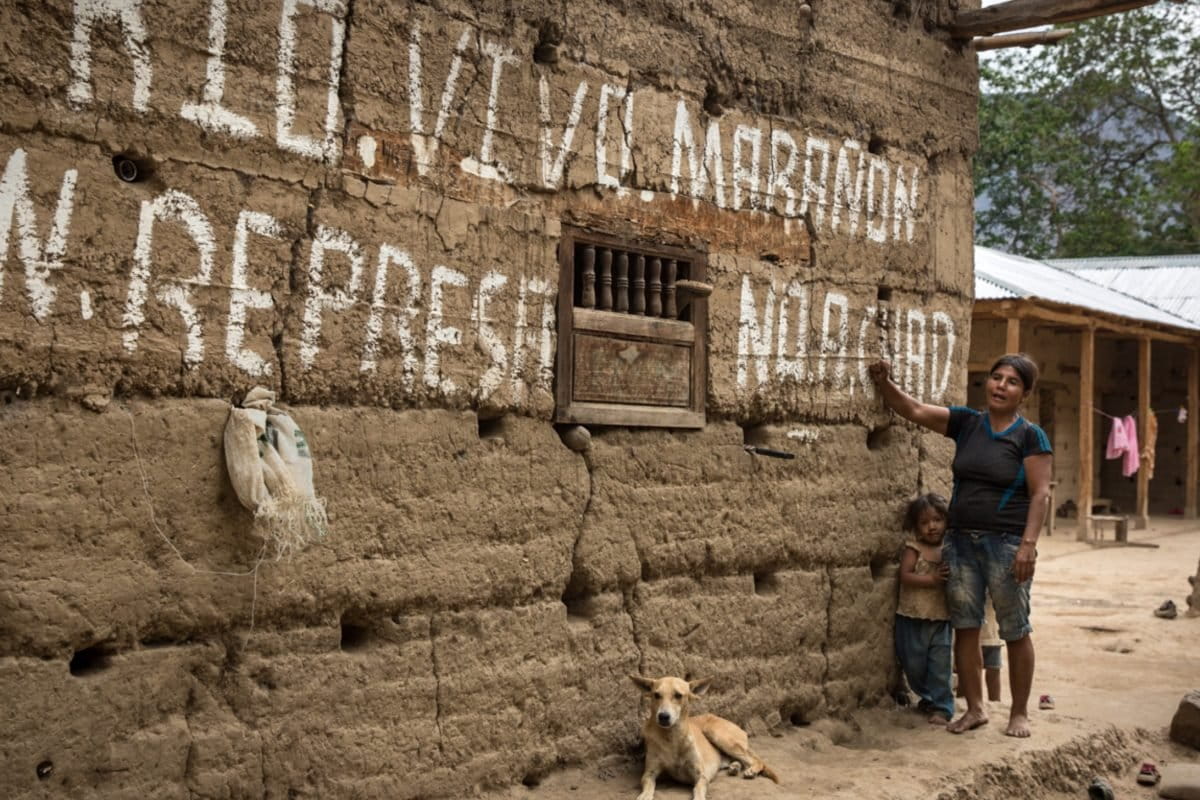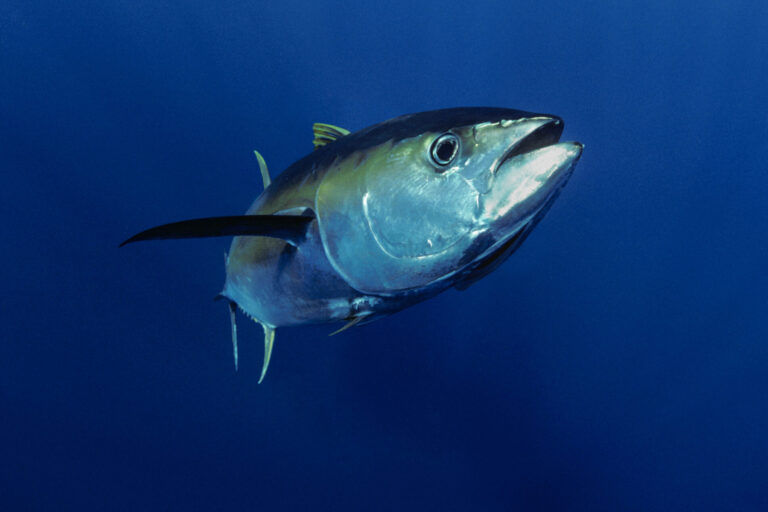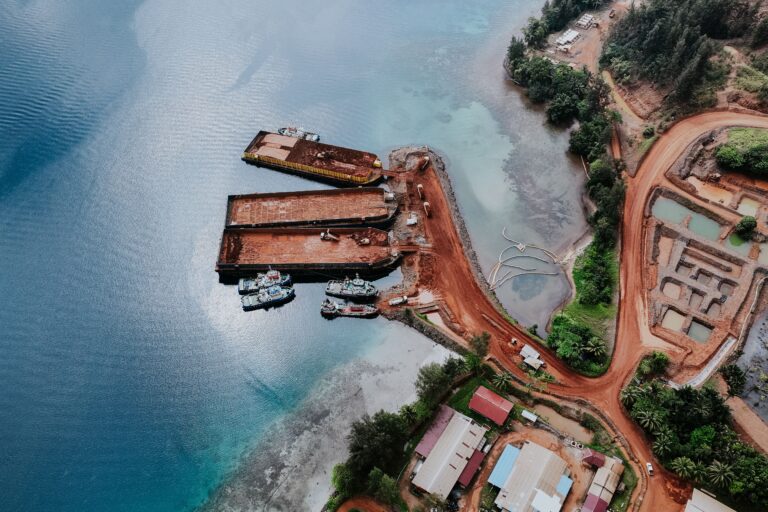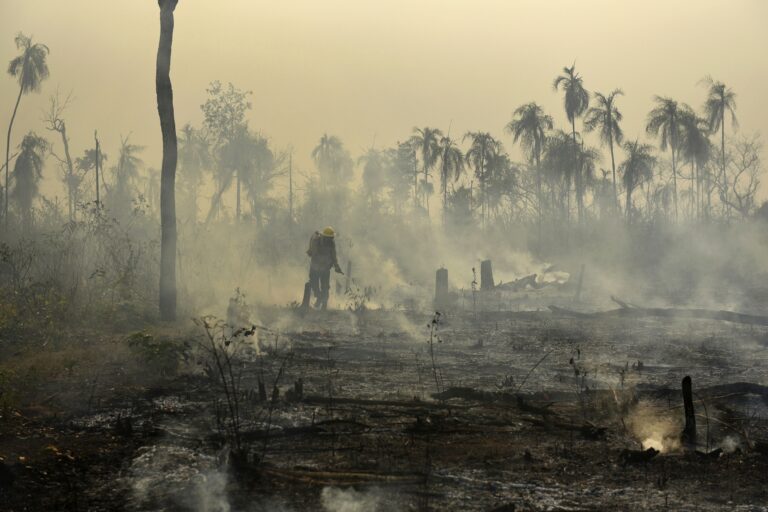- Odebrecht has the final agreement for the Chadín II hydroelectric project and is looking to achieve the same for the Río Grande I and II projects.
- These hydroelectric dams will convert the Marañón into a swimming pool more than 100 kilometers long.
- Neighboring countries such as Argentina and Chile have set a target of achieving up to 70 percent renewable energies for 2050. In Peru, there is no such plan.
After finishing his plate of yuca, rice and fried plantain, César Chávez received a call that he could not answer because his mouth was full. When he swallowed the last bite with some effort, the ringing used up what was left of the battery.
Chávez is about to turn 40 years old and is the president of the Tupén Grande peasant patrol (rural self-defense groups), a small village in the Amazon, located next to the Marañón River in the north of Peru. Like everyone here, he must charge his cell phone with a generator which uses oil to work.
The population of this old village situated five hours on foot from the closest road is home to part of more than two million Peruvians who are still without electricity, according to data from the Ministry of Energy and Mines (MINEM). Their only permanent energy source here is a solar panel the size of a table for four people that charges the laptop of the only teacher at the school. In Tupén Grande, the sun seems to have dried everything, but you only have to walk closer to the river to see fields of oranges, yuca, sweet potato, coca, banana, mango, plums, avocado, mandarins and even cacao.
The fertile land of the Marañón is how the Peruvian writer Ciro Alegria describes it in his work “The Golden Serpent.” Meanwhile, in the shade standing in the doorway of his house, Chávez tries in vain to turn on his phone once more, resigning himself to being uncontactable in a place in Peru where it is surprising that there is signal.
On the outside of Chávez’s house, it says “No to Chadín,” a phrase which appears on many other walls in the village. Chadín II is a mega-hydroelectric dam, 175 meters high that will cover 32.5 square kilometers of territory in water, a size equivalent to the districts of Lince, Pueblo Libre, Miraflores, San Isidro, Magdalena y Breña in Lima. It is as if an area 28 times the size of the Retiro Park in Madrid was going to be flooded.
This project is one of the twenty that are being planned for the Marañón River basin thanks to a supreme court decree issued in April 2011, during Alan García’s second term, a time in which to produce renewable energies, such as solar or wind power cost up to four times what it costs today.
However, it was Ollanta Humala’s government, with a highly criticized Environmental Impact Study (EIS), which awarded the Chadín II project to the Brazilian company Odebrecht. The president of the company, Marcelo Odebrecht, was sentenced in Brazil to nineteen years in prison for corruption crimes, money laundering and criminal association.

In addition to Chadín II, Odebrecht has been awarded the mega-hydroelectric dam project in Veracruz (ENEL-ENERSIS) and two other projects are in the approval process: Río Grande I and II (Odebrecht). Together, these four damns dams will convert the Marañón into a swimming pool more than 112 kilometers long and will displace more than four thousand people.
Impressive river
In the Balsas district in the Amazonas region, at two o’clock in the afternoon it feels as though it would be possible to boil water in the sun. Twenty people with helmets, life jackets and paddles were getting ready to climb into inflatable boats to travel down the Marañón River for one week.
The group of travelers was varied. American activists from the Waterkeeper Alliance who came to meet the river’s defenders, university students, artists, athletes and foreign tourists who travel all over, looking for unique and little-known experiences. There were also representatives from NGOs, who will join in a campaign to defend the Marañón.
What awaited us were moonlit nights, beaches with white, soft sand, and imposing rocks with millions of years’ worth of erosion by this river that kilometers later creates the Amazon, the same river that makes up one-fifth of the planet’s freshwater, which is as much as the Nile, the Yangtze and the Mississippi together.

The Marañón River begins in Huánuco, passes through Ancash, La Libertad, San Martín, Cajamarca, Amazonas and in Loreto it joins with the Ucayali to form the Amazon river. It is the main tributary of the largest river on earth. Likewise, the dry forests of the Marañón are among the most special in the world due to their diversity and endemism.
Birdwatchers and naturalists travel thousands of kilometers to see animals and plants that are at risk and that only live in this part of the planet, such as the little Inca finch (Incaspiza watkinsi), the Marañón pigeon (Patagioenas oenops) or the Marañón crescentchest (Melanopareia maranonica), which lives alongside the spectacled bear, puma and reptiles like the small-eyed lancehead.
In its lower parts live the Awajún and Wampis indigenous communities, which depend on the river. The Wildlife Conservation Society (WCS) carried out a study which identified 156 types of fish living in the channel of the Marañón at the height of Pongo de Manseriche. Each of these need the connectivity of the river to move around and feed. If walls are constructed, they will die.
In Tupén Grande, everyone distrusts strangers. Before answering any questions, they make sure that the person does not come from Odebrecht. They accuse the company of dividing the community with its money and of being unclear with its communications. They say that Odebrecht have offered to create a road for them so that they can transport their fruits and products if they accept the dam. A generous offer if they had cocoa, mandarins and oranges that can grow underwater. On its own, the Chadín II would affect the districts of Chumuch, Cortegana, Celendín, Pisuquia, Ocumal and Cocabamba, which are spread across the Cajamarca and Amazonas regions.

In the last days of June 2014, the Tupén Grande peasant patrol group intervened three Odebrecht employees who came to the area to gather information. As they were seen in the Yagén area, they called for members of the Yagén round to hand them over. They were held for four days doing physical activities before they were released to the police.
Yagén members faced a kidnapping trial in which the Odebrecht employees requested a custodial sentence of no less than 30 years for fourteen of them. The Political Constitution of Peru, in article 149, recognizes the administration of justice on the peasant patrol groups. They say that they did not harm the Odebrecht employees and only carried out work that the law allows.
However, the trial continues and they hope to be acquitted. According to Mirtha Vásquez of the NGO Grufides, this crime has been exaggerated since they were in the communities’ territory and, as detailed in the medical reports, the three people showed no signs that they had been mistreated. Vásquez claims that they are denouncing anyone who opposes the mega investment —even though the peasants are only trying to protect their lives.
In the Odebrecht offices in Lima, they claim that they have not started working in the area of influence, and that when they do, they will comply with all requirements set by the state and the Marañón communities – the same ones that blame the Brazilian company for a lack of transparency.
On YouTube there are dozens of videos of participatory workshops and talks organized by Odebrecht in which people from these communities are not allowed to enter. These informative meetings must be carried out by law in each of the affected communities to ask for social license from the residents. According to Milton Sánchez, secretary of the Celendín Interinstitutional Platform (PIC), an organization which brings together different movements, collectives and people who defend the environment in the Celendín province, they fill their meetings with people from other sectors who sign the minutes in exchange for gifts.
Hugo Cabieses, former Vice Minister of Environment in Peru and advisor for the Cajamarca regional government, confirms what Sánchez says and adds that all of this is a joke where the reality impacts more than any type of fiction. For Cabieses, since the extractive industries arrived in Cajamarca, more than twenty years ago, they have not helped the development of this region. According to the Peruvian National Institute of Statistics and Informatics (INEI), more than 50 percent of the country’s population is poor, reconfirming it as the country’s most needed department.

In the Lima offices, the Odebrecht representatives prefer not to give interviews in person and instead respond to everything by email.
“Odebrecht have always been concerned with keeping residents and communities informed,” wrote Sonia Donayre, Manager of Institutional Relations, denying all accusations. She added that public events are always open to all, but some groups have come simply to stir up trouble.
She also confirms that they will only start to build Chadín II when the State requires it, since at this moment the country has a lot of energy reserves.
A matter of necessity
The only thing that César Chávez knows with respect to energy is that it does not reach his house and that converting the Marañón into a bathtub will not generate light for Tupén Grande.
Currently, Peru consumes 6,500 megawatts (MW) at peak demand each year. It has a generation capacity of more than 10,000 MW. More simply, the country has almost 50 percent of the energy it produces left over. Peru generates so much energy, that by 2018, this reserve will reach 70 percent, following MINEM projections. That is to say, production vastly exceeds demand. Yet the State has still not achieved bringing light to every corner of Peru.
“We have strategic planning problems for the medium and long term,” said Pedro Gamio, Vice Minister of Energy and Mines in the second government of Alan García. “We have serious deficiencies in the provision of basic services. It cannot be that there are millions of Peruvians without electricity in their houses. We depend a lot on oil when we have great potential in solar and wind energy.”
Of the energy that Peru consumes, 48 percent comes from a resource, that according to experts such as Gamio, will be completely used up in less than 20 years, and another 48 percent comes from hydroelectric power plants. Around 4 percent is covered by renewable technologies, such as solar or wind.
Of the hydroelectric plants, one in ten uses technology with reduced volumes of water and instead of flooding large spaces, these use heights and waterfalls to generate energy. For the Marañón, however, the last two governments have shown their predisposition for turning it into a pool of water like so many rivers that have also been impacted across the world.
Between them the U.S. and Mexican governments, five dams were built on the Colorado River, which have caused the disappearance of birds, wild cats, and even indigenous fishing and agricultural communities. One of North America’s most important rivers reaches the ocean with the water pressure of a hose.
On the Columbia River, fourteen dams are decimating salmon populations. The Pak Mun Dam in Thailand eliminated fifty-one animal species. Built to generate approximately 300 MW of power, two dams on the Senegal River and their pools of water have resulted in the spread of malaria, urinary schistosomiasis, diarrhea, and parasitic diseases, and the loss of 11,250 tons of fish.
Against this backdrop, within the last few weeks in Chile the company Endesa Chile canceled five hydroelectric projects in the Chillán, Futaleufú, Cautín, Puelo, and Huechún river basins, finding that they would have undo social and environmental impacts. In Brazil, the San Luiz do Tapajós hydroelectric mega-dam in the state of Para was just denied an environmental license for the same reason, and due to the fierce resistance of local communities to being inundated with water.
Energy generation is a good excuse for construction and profit. At least 1.65 billion dollars will be invested in Chadín II alone, which is an underestimate according to a study on mega-dams by the University of Oxford. In practice, costs are double the initial figure. Transporting turbines and trucks, opening paths with gigantic machines, and carrying all that concrete to Marañón sound like production for one of Werner Herzog and his Fitzcarraldo’s modern adventures.
For José Estela, General Manager of Sami Energy Consulting and who has decades of experience in managing hydroelectric plants and energy, the reality is otherwise, and these future exploits are nonsense. In his recent study for WWF Perú, “Strategy for Green Hydropower in Peru,” he details how wind and solar alternatives are now much more competitive, as well as how small- and medium-sized hydroelectric dams can be built to utilize waterfalls without affecting their surroundings.
Estela states that Peru’s wind generation potential is at least 22 thousand MW and, with levels of solar radiation among the world’s highest on the coast and southern mountain ranges, it has the potential for up to 30 thousand MW more. It is energy without flooding or destruction.

No thought for the future
Alberto Ríos is a Peruvian engineer who works in Lima, Madrid, and Quito. He has studied renewable energy and electrical networks in Spain, Belarus, Ecuador, and Peru, and travels the world teaching and giving talks on better energy consumption. He does not drive a car or own a cell phone. He gets around on a bicycle and has not purchased clothes for several years to avoid using more energy.
For Ríos, unplugging the computer is a duty when so many natural spaces might disappear in the name of national interest. At the end of May, Ríos presented a study, “Energy in Peru,” conducted for Fórum Solidaridad and International Rivers, non-governmental organizations that promote a more just society and the protection of rivers.
Ríos confidently states that, “Peru’s challenge is saving energy. And doing that is the responsibility of all of us.”
He also speaks of the need for a land registry.
“We must be clear where large construction projects can be built and where they are unfeasible,” he states. “The Marañón River is an example. How can we allow this space, the only one of its kind in the world, to be buried?”
Back on the banks of the Marañón River, César Chávez has resigned himself to sitting on a round stone and not charging his phone. He says that none of the communities will allow these projects to become viable, for the good of the river and their families. Chávez states that the national interest must manage to bring electricity to every corner of the country without destroying our forests and heritage.

Not far from there, in the middle of the jungle of San Martín and Loreto, the 220 kV Moyobamba – Iquitos Transmission Line is to be built, measuring 600 kilometers in length.
“While in theory this project is to benefit the people of Loreto, it will destroy the Abanico del Pastaza, which possesses some of the greatest biodiversity in the Peruvian jungle. It has over 300 fish species and the remnants of a gigantic lake that existed at the center of the continent 10 million years ago,” said José Serra, an electrical engineer and consultant who has studied hydroelectric plants and renewable energy in Peru. “When the Achuar indigenous communities realized they would not receive a single watt from the line, they decided to stand against this investment, which would pass alongside the Allpahuayo-Mishana National Reserve.”
Serra is among those who emphatically oppose building the line and the mega-dam projects on the Marañón River.
In April 2016, the Ministry of Energy and Mines denied the environmental impact assessment (EIA) presented by the Spanish company Isolux, which holds the concession for the transmission line. They marked 131 objections, and 70 were not responded to. Nevertheless, at the end of July of the same year, on the last day of Ollanta Humala’s term —Peru’s former president— the vice minister of Energy and Mines, Raúl Pérez-Reyes, invalidated the denial of the EIA and accepted new corrections and contributions from the company, leaving open the possibility of soon commencing work.
At that time, neither the then-minister of Energy and Mines, Rosa María Ortiz, nor Pérez-Reyes, who continues to hold his post, were willing to give statements for this report. Weeks later, Pérez-Reyes was contacted again, but his press officer stopped answering calls and mail. José Estela says that the line is unjustifiable when Loreto has better options, such as the Mazán hydroelectric dam, solar energy, and biomass energy. These could be implemented in small villages and communities where laying extensive lines, which would hurt the jungle and its people, makes no sense.
According to the Energy and Mining Investment Supervisory Body (Osinergmin), in Peru the cost of wind or solar power production is almost half that of hydropower. The most recent report from Bloomberg New Energy Finance (BNEF) states that by 2040, 60 percent of energy capacity worldwide will come from wind and solar, which will be up to 60 percent cheaper. By that same year, the United States plans to reach 50 percent renewable energy and in Europe some countries will reach 70 percent. Chile has set targets of 20 percent renewable energy by 2025 and 70 percent by 2050.
In Peru, Pedro Gamio says, “Quality of governance is an issue. We are not as interconnected with the world as we should be, and we have not set any goals.” As of 2016, Peru’s renewable energy production is barely 4 percent, and further construction of mega-dams is planned. Such dams flood large spaces, concentrate mercury and other minerals, poison plants and animals, and through decomposition and biomass putrefaction produce methane, which is up to thirty times more potent a pollutant than carbon dioxide, as studies from the World Commission on Dams (WCD) and the Interamerican Association for Environmental Defense (AIDA) have shown.
“The Marañón carries sediment and nutrients from the Andes to the lowland forest. Obstructing it would significantly affect the species and people living downstream,” said Carlos Cañas, biologist and coordinator of the WCS initiative, Amazon Waters.

The Camisea Gas Project, which provides almost half of Peru’s power, will run out in twenty years. No plans have been made for when that occurs. This government’s main mission is to find alternatives like more wind and solar farms, conduct further research into geothermic energy, and promote medium- and small-sized hydroelectric dams on rivers and streams. The nightmarish concrete blocks have gone out of fashion. For many years, international organizations such as the World Bank promoted the construction of mega-dams.
Nevertheless, the last WCD determined that nothing justifies their negative impacts. The International Hydropower Association, the International Finance Corporation, the WCD and the Environment, and the OECD Guidelines for Multinational Enterprises outline standards that we would violate with these monumental projects: dam walls should be no more than 50 meters high; in tropical areas dams should not be built below 1,000 meters above sea level due to impact on vegetation; and dams should not be built on rivers with high water flows or on main-stem rivers like the Marañón. This guidance should be taken seriously if mega-dams are still considered the best option for renewable energy, and if the country is to reduce emissions 30 percent by 2030 under the Paris Agreement, ratified at the end of last year.
“Peru is among the ten countries most vulnerable to climate change,” Gamio said. “We must build infrastructure appropriate to this scenario. We must also decentralize energy generation and promote renewable energy. We have great potential, but we are wasting it.”
The greatest fear in Tupén Grande is losing their homes, food, and jobs. Like his neighbors, César Chávez has a small orchard and takes the fruit to Chachapoyas to be sold. When they do not have the money to pay the mule and then the trip on the highway, they eat what they grow. They cannot afford a second-hand motorcycle, but they do not lack for food. Building the Chadín II hydroelectric dam appears to be an answer to the lives of Chávez and his community. It will create 3,000 jobs, and according to Odebrecht priority will go to the locals, who will be trained through the company’s free professional training program, CREER. They will receive workshops on everything from heavy machinery to carpentry. Such training would make more sense if the communities did not have to be relocated. Get a job, lose your home is not a deal the people want.

José Estela hopes to convert his Lima office into a sustainable energy laboratory, where he can generate his own electricity. He thinks it is unhealthy to pay so much when solar panels can be used to charge computers, watch TV, and turn on the bathroom light. Such an example could be replicated across the country. Opting for renewable energy, which is already more economical than traditional sources, in industry and mining. Reforming transportation, which is the main source of pollution. Promoting natural-gas and then electric cars. And encouraging a culture of thrift in homes and businesses. A penny saved is a penny earned—a cliché that should not be hard for us to put into practice.
The sun has set. César Chávez walks slowly down the bank of the Marañón River, side-stepping smooth, marble-like stones. He points to the sky as it darkens, to where the Chadín II dam would be raised above the town of Saquilillo. He pauses with his neck bent, staring into the distance, and wonders:
“Must this all be destroyed? Is there no alternative?”
This story was reported by Mongabay’s Latin America (Latam) team and was first published in Spanish on our Latam site on September 14, 2016.













